The Making of IGPX 3D Animation Step 2: Texturing
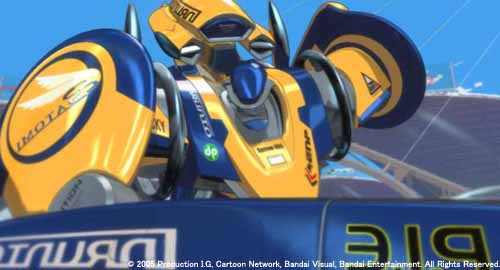
Hyper-dynamic battles between lavishly detailed IG machines running at speed higher than 400 km/h is definitely one of IGPX most impressive characteristics.
For this reason, we decided to get inside Production I.G's 3D Room, and ask the computer graphics team to tell us everything about the creative process behind the astounding mechs of IGPX.
STAFF PROFILE
Miki Yoshida
3DCGI. Yoshida is the leader of the IGPX 3D animation team. His main works include: Blood: The Last Vampire (2000), Kaidohmaru (2001) and Ghost in the Shell: Stand Alone Complex (2002).
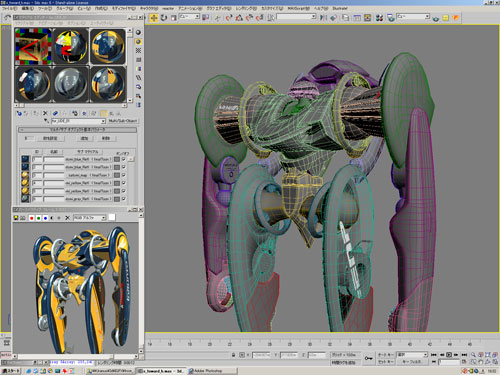
What is the process called texturing?
Yoshida: It includes coloring the machines that come out of the modeling process and also determining the texture of the surface in order to create a sense of three-dimensional objects. The color coordinator would make different color settings for each sequence, such as daytime, nighttime, inside the mechanic room and so on, and we create color textures according to those settings.
Let me give you an example. For Team Satomi's machines, the basic colors are yellow and blue, and I use about six tone variations per machine. If you just add colors, the surface would look too smooth. The 3-D director Takeuchi-san asked whether we could process the colors to make them look more real, by using something like special effects in the cell drawings, such as airbrush and so on.
He had an image of something in between the smooth surfaced cell drawings and the realistic 3-D textures. This was something entirely new to us. I worked out how to realize this by processing the texture data.
I asked our special effect specialist Masahiro Murakami to do a special crash course for me. His advice was very to the point, such as "it's better to reduce reflections in the shady areas of the machines." If you put reflections on the shady areas, it will turn out like a shiny copper surface. I was very thrilled, because he taught me about special effects in 2-D images, which I would never think of in the 3-D process.
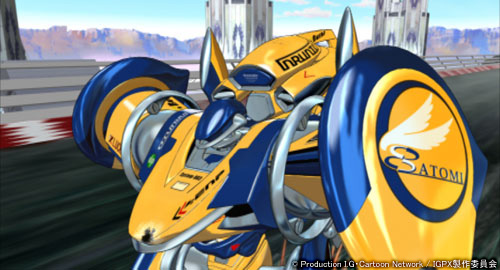
For example, machines for Team Satomi are basically yellow and blue, but if you make blue light reflect over the yellow areas, it looks more real. This is a technique that involves putting reflections of the surrounding color over the main color.
If it's a daytime scene, we laid blue-colored texture, and for the mechanic room, we laid the texture in the color of the indoor light. When we get a thumbs-up from Murakami-san, that's great encouragement for us.
What is texture data?
Yoshida: As for the base colors, it's a very small square-shaped piece of image data. For reflection data, which I just explained, the data squares are slightly bigger. I mainly map textures I draw with Photoshop. You can think of this process as laying little data tiles no matter the shape of the modeled objects.
A particular detail we added was the stencils. The director Hongo-san requested that we put sponsor logos on the IG machines in IGPX just like with the real F1 machines. This specific data is called a stencil texture. It is different from the tiling data I just mentioned. Here we layered logos and sign-shaped image data, in a process similar to putting decals to the plastic models. This made the resulting image quite presentable.
The assistant sequence director Makiko Asano created the stencil data for each machine. We layered them onto the machines according to the blueprints provided by the two mechanical designers who specified the exact layout. Team Satomi's machines had the greatest number of stencils; about 50 in total.
We first laid base color tiling data on the surface of the modeling data; then we put the stencil data; and on the very top we layered the reflection data.
Can you tell us about the stock of texture materials?
Yoshida: As for stencils, we used the same sponsor stickers within the same team, so we only had to make them at the beginning. And also for the machine colors, each team share the base colors, so we used the same tiling data.
As for the texture data for the background such as the sky and buildings, we asked Studio Bihou [note: the studio in charge of the backgrounds] to draw them put for us. We prepared blueprints that were line drawings of the 3-D models. Then we asked our 3-D director Takeuchi-san to give us the detailed specification, which we forwarded to Studio Bihou. The finished background drawings were used as the texture data. The main stand of the racetrack circuit was divided into very small portions, so there were about 80 to 100 pieces of material that were laid down.
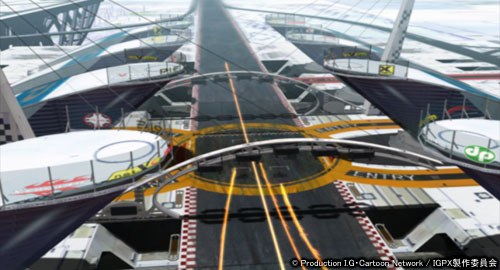
Some of this work was done by Studio Bihou. We sent them our modeling data, which specified where to lay the data, and they did the work for us.
There is also a special texturing method called camera mapping. This is done not by "laying down" the texture, but by "projecting" the texture onto the object. This lets a 2-D background drawing to move in three dimensions to some extent. You can see an example in the earlier scenes of Episode 2, where the Big Eye slowly circles in the sky over the racetrack circuit.
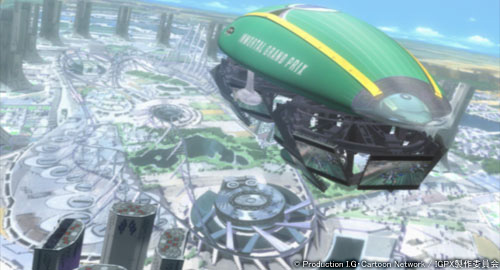
Where do you have to pay special attention to in the texturing process?
Yoshida: I try to align the texture to the line that is perpendicular to the surface of the object. And when the low model for processing becomes a high model for the finishing process, the number of polygonal faces may sometimes increase, and the texture images consequently go out of alignment. For this reason, we try to increase the faces in the low model before applying the textures.
Problems could also occur while adding many layers of texture data. We sometimes have to adjust flaws such as a lack of the body color around the stencils on the machines or reflective effects that have disappeared.
We have to do detailed work over and over, but after all the toil we get such a neat and incredible result, so it is quite rewarding. Especially the flame pattern we laid over Sledge Mama's machines. They are so impressive. I hope that the audience would appreciate it too.
© 2005 Production I.G, Cartoon Network, Bandai Visual, Bandai Entertainment. All Rights Reserved.

![WORK LIST[DETAILS]](/contents/works/design/images/left_title.gif)



 terms of use
terms of use